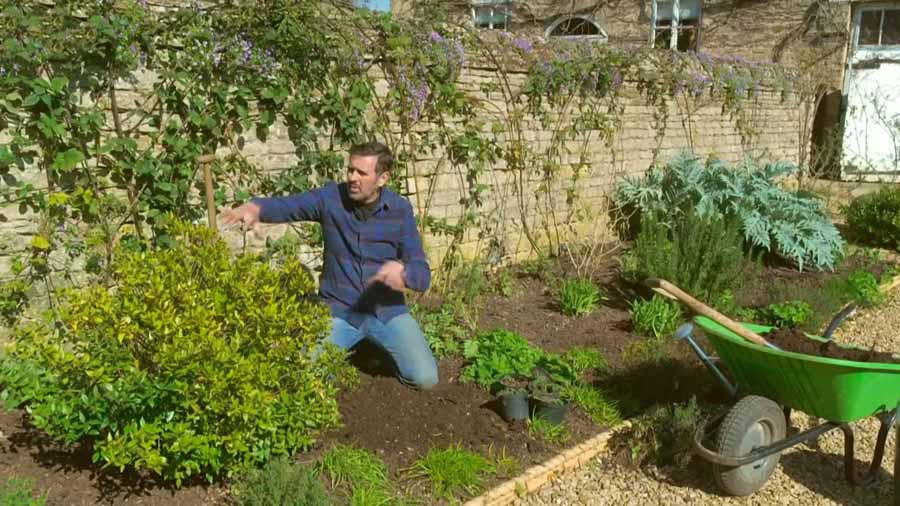Gardeners World episode 4 2020: Adam Frost is in his garden providing inspiration and discussing all the essential gardening jobs for this weekend.
The Gardeners’ World team present seasonal highlights from across the country, visiting stunning gardens, meeting the gardeners and finding out their secrets of success. Gardening show packed with good ideas, tips, advice from experts and timely reminders to get the most out of your garden, whatever its size or type.
Gardeners World episode 4 2020
How to make a gravel garden for wildlife
Surfaced spaces have all kinds of uses. You may need off-street parking, or a low-maintenance alternative to a lawn; a path running between flower beds, or just somewhere to sit and enjoy the garden. There are many surfaces to choose from – paving slabs, poured concrete, granite sets, bricks, decking, turf … But, on balance, gravel can be one of the more hospitable options when it comes to wildlife. Not only is it low-maintenance and relatively cheap for you, but it provides the perfect environment for drought-tolerant planting, attracting wildlife when other parts of the garden may not.
Plums, gages & damsons
Plums, gages and damsons are all stone fruits that thrive in sheltered, warm gardens. Although they all bear the same basic type of fruit, their taste varies from tart and spicy, to sweet and perfumed. All these have their uses, so the final choice is usually a personal one.
Plums, gages and damsons are closely related. Plums are large, usually soft-fleshed – perfect for eating or cooking (depending on the cultivar). Gages are small, round and sweet, but grow best in a sunny spot. Damsons are especially hardy and have a spicy, tart flavour and are good cooked and jammed. The most useful cultivars to grow in a garden are listed below.
How to grow strawberries
Strawberries are easy to grow, and even a few plants can give a plentiful supply of sweet succulent fruits in summer, which are especially appreciated by children. A bed of strawberries usually lasts up to four years if planted into well-drained, fertile soil free from troublesome weeds. To avoid disease build-up, choose a different plot and replant strawberries every three years. Strawberries will tolerate shade, but will thrive in sunshine, and they prefer a slightly acidic soil.
Before planting enrich the soil by digging in two bucketful’s of well-rotted manure or garden compost per sq m (sq yd). Forking in a balanced fertiliser, such as Growmore, at 100g per sq m (3oz per sq yd.) will also help produce good yields. Strawberries can also be grown in raised beds where drainage is poor.
Unless growing through polythene, protect the developing fruits from wet soil by tucking straw or special ‘strawberry mats’ under the fruit as they begin to swell. Some prefer to use barley straw as it is soft, but wheat straw is fine to use too. If frost threatens, protect the early flowers overnight with horticultural fleece.
Blueberry know-how
Not only are blueberries productive, their glorious autumn colours provide ornamental appeal. The fruit is delicious and high in antioxidants. Shrubs can be grown in the garden border or as attractive container plants.
Blueberries are relatively easy to look after. Keep the compost or soil moist, but not soaking wet. Don’t allow it to dry out between waterings. Water plants with rainwater, not tap water, unless you have no alternative in a drought. Tap water will raise the pH level and blueberries like acidic conditions.
Ensure the soil stays at pH of 5.5 or lower, to avoid problems. Check the pH of the soil in spring and add sulphur chips if it needs lowering. This shouldn’t be necessary with container-grown plants provided ericaceous fertiliser and rainwater are used.
Grow your own raspberries
Raspberries are one of the most popular summer fruits and are very easy to grow. Different training techniques mean raspberries can be grown in gardens of any size and in containers.
Raspberries thrive in moisture-retentive, fertile, slightly acidic soils pH 6.5-6.7, which are well-drained and weed-free. They dislike waterlogged soils and shallow chalky soils. For best results, plant in a sheltered, sunny position. They will tolerate light shade, but the yield is likely to be reduced.
In early March, apply Growmore or naturally slow-release general fertiliser, fish, blood and bone for example, at 30g per sq m (1oz per sq yd), then mulch with well-rotted organic matter. If the growth is weak, apply sulphate of ammonia at 30g per sq m (1oz per sq yd) or dried poultry manure pellets at 90g per sq m (3oz per sq yd).
Keep raspberries well-watered during dry periods, but avoid overwatering. Avoiding drought stress is especially important during fruit set and development. Apply water preferably at ground level; drip irrigation systems or a leaky hose is ideal. Keeping the foliage, flowers and developing fruit dry helps to reduce the risk of fungal diseases.
